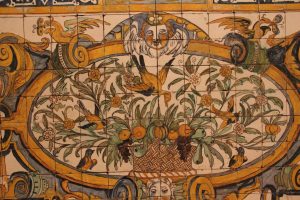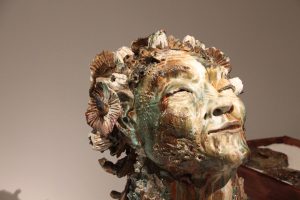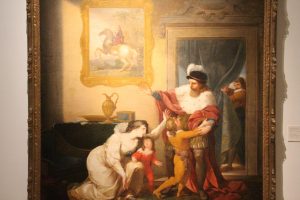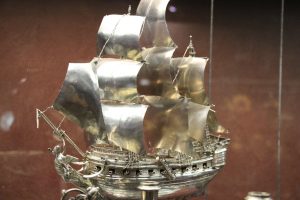This version is just one button.
Click on the button to hear Steven read the post.
This version is a player bar.
Click on the button to hear Steven read the post.
- Our Last 2 Days in Lisbon
October 11th
Click on the button to hear Steven read the post.
We had two good days exploring Lisbon. We got comfortable using the buses and trams and managed to get where we wanted with a minimum of fuss. The weather was on-and-off rainy on Thursday but it cleared up nicely on Friday. Because we weren’t sure about the weather we changed our plans a little and we did not take a train out to the small town of Sintra, which used to be a summer place for royalty and which has several buildings and a nice setting we would liked to have seen.We had been told and we had read that the National Tile Museum was a “must see.” All too often a “must see” turns out to be a “could have skipped it” but not in this case. We had a very nice visit to a former convent which now houses a museum full of works of art and Portuguese history. The museum is out to the east of where we stayed and that meant figuring out a new bus route. Hint: Google maps can be a big help. We arrived before the crowds and spent several hours in the uncrowded space going from one area to another that showed some Portuguese history via various tiles. Some were small decorations while others covered one or more walls. But there was far more than a collection of tiles; we saw the convent’s church, which is very beautiful and which is decorated not only with tile, but also with pictures from the 1600s—and a somewhat gruesome skull and cross bones and a vial of the blood of a martyr.
For reasons I do not pretend to understand, tiles have an important place in Portuguese history and culture. The museum presented a lot of information about tiles and how/when they were made, but I am still not clear on the cultural importance. The items in the museum were clearly annotated in both Portuguese and English, so it was straightforward to follow the development from the times of the Moors through the present day.
In addition the historical tiles, there were two exhibitions going on. “Undersea Art” by Sylvain Bongard is an installation of ceramics depicting man’s impact on sea creatures and some imaginary creatures. The art was “interesting.” I posted some pictures on the pictures page and I will post more when I process all of our photos at home.
The second exhibit, “Places where I’ll be” by Cristina Bolborea offers several pieces of ceramics that could easily be mistaken for pieces of carefully arranged fabrics with designs, along with other glass and metal pieces that are meant to evoke Islamic markets. I was impressed with both special exhibits.
We almost, but not quite, got rained on a few times on Thursday including while we sat outside at the Café St. Nicolau on busy Augusta street near Figueira Square for a late lunch. The people watching is more interesting to Patricia than to me, but there were plenty of people to watch.
Friday the forecast was for improved conditions but we decided to stay in Lisbon rather than go out to Sintra. It was a good choice. We visited the Museu Nacional de Arte Antiga (Museum of Ancient Art) for several hours and saw both Portuguese and European art from the 1300s to the 1800s. The museum itself is housed in the 17th-century Palace of Janelas Verdes (“Green Windows”). I did’t realize it until our visit, but in the early 1800s Portuguese religious orders were abolished and much of their art and wealth was confiscated. [For the good of the people, I am sure.] I had wondered why so many of the things we read about and visited were housed in churches, monasteries, or convents and here was the answer. I suppose I could feel bad about the confiscations, but I prefer to just appreciate what we saw.
And we saw great art at the museum. We had the tiniest bit of a problem getting there because we couldn’t figure out how to make the trolley stop near the museum, so we rode all the way to Belém and had to come back. We were a little frustrated when we got there but that frustration evaporated instantly when we began to look at the collection. Now that I know that a lot of the art was confiscated, the fact that so much of it has religious themes is not surprising. [A lot of the art from the 1300s to the mid-1600s throughout Europe was sponsored by religion.] Whether religious or not, the quality of the work, whether painting or precious metals, was outstanding. I have posted some pictures on the pictures page, and I will post more when we get home, but much of the work can only be appreciated firsthand. I suspect that the museum has done a lot of conservation work because the colors on some of the paintings just leaps out at you.
The way the rooms and spaces were arranged was careful and offered a chronological look at Portuguese art. The European art was arranged a little differently—more or less by country . Among the highlights were the were the St. Vincent panels, a Portuguese national treasure, from 1470 (Nuno Gonçalves ) and the Supplication of Inés de Castro (Francisco Vieira, ca. 1803).
The Inés de Castro painting was so interesting that I did a little background search to learn something about it. I discovered that her story (e.g., Wikipedia) is important to Portuguese history, but you don’t need to know that to appreciate the picture.
We also saw “St. James the Greater” by José de Ribera (ca. 1634), which was on loan from the Fine Arts Musum in Sevilla, which we had visited the week before. This is a striking portrait because of the direct gaze (I’d call it a stare) which seems like it is looking inside you.
In addition to the paintings, we saw many pieces of gold and silver. The work and artistry of the jewelers (if that is the right word) was astounding. Many of these works also had a religious theme.
By mid-afternoon the weather had cleared completely and we stood in the garden of the museum for a while to take in the view of the port and river and the buildings along the river.
In the evening we went back to Chapito, the restaurant up the hill from us and just down the hill from the castle, to sample more tapas. We enjoyed our last Lisboa dinner.
We had an easy trip from Lisbon to Madrid where we will spend Sunday before heading home on Monday. We have had a great time, but we will also be glad to get home.
More pictures on the pictures page.
Continue reading →






